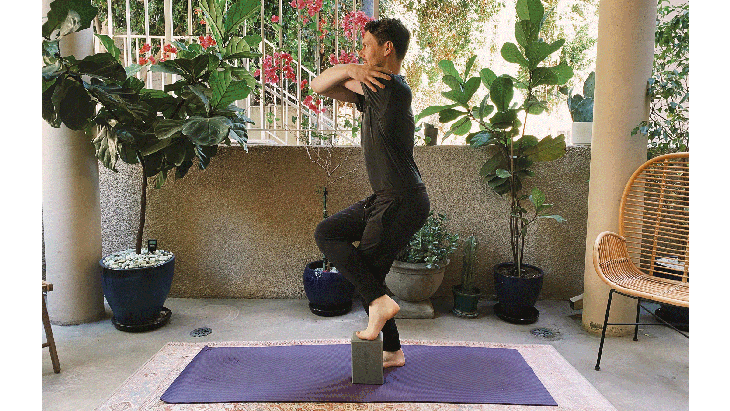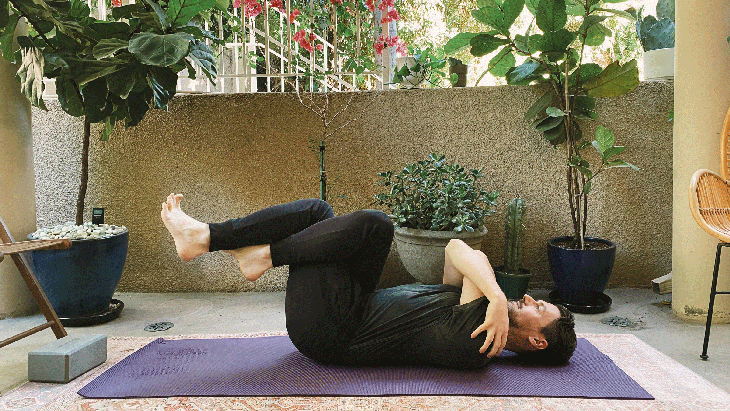4 Ways to Practice Eagle Pose
This article originally appeared on Yoga Journal
Have you ever heard the phrase "advanced practitioner" in a yoga context and wondered what exactly that means?
Many of us mistakenly assume it is someone who practices yoga and meditation every day, or who can come into each posture's "full expression" (an ableist term I intentionally avoid in all my classes).
By my definition, you are an "advanced practitioner" if you are able to tune inward during a yoga practice and make the correct decision for yourself with each pose based on what is happening for you, physically and emotionally, in that moment. This could mean choosing to take a restful position rather than doing an extra Sun Salutation A. Keeping a less intense degree of bend in your front knee during a Warrior Pose. Or using a prop to support yourself in a challenging pose such as Garudasana (Eagle Pose).
The traditional version of Garudasana asks you to stand on one leg and wrap your other leg over and around it. Then you wrap your arms around each other, too, perhaps with your palms touching. It improves your balance, focus, and concentration. It also stretches your shoulders, upper back, IT band, and outer hips and strengthens your core, inner thighs, and muscles of your standing leg.
But Eagle Pose can be intense, to say the least, and it's about as pretzel-y as many of us aspire to become in our yoga practice--particularly those of us who are challenged by balancing or tightness in the shoulders and hips.
As with any pose, there are many ways to approach it so that you can find a variation that works for your individual needs in any given moment.
4 Eagle Pose variations
Preparation
Utkatasana (Chair Pose) and Vrksasana (Tree Pose) help prepare your legs for Eagle Pose. Marjaryasana–Bitilasana (Cat-Cow Pose) and Thread the Needle help stretch your shoulders in the necessary ways. Gomukhasana (Cow-Face Pose) prepares both arms and legs.

1. Traditional Eagle Pose
Begin in Tadasana (Mountain Pose). Reach your arms out to the sides at shoulder height and draw them forward toward each other, crossing your left elbow over your right arm. Bend your elbows and try to bring your palms to touch. Lift your elbows without crowding your shoulders toward your ears.
Shift your weight into your left foot, bend your right knee, lift your right leg, and slowly cross it over your left thigh. Hook your right foot behind your left calf or place the outer edge of your right foot against your outer left calf. Draw your right hip back to keep it in line with your left hip. Gaze straight ahead.
Tip
Instead of bringing your palms to touch, you can hook your thumbs or bring the backs of your hands together. Instead of wrapping your arms, you can cross your left elbow over your right and then place each hand on the opposite shoulder as if to hug yourself.

2. Eagle Pose with a block
Begin in Tadasana (Mountain Pose). Place a block along the outer edge of your left foot. Reach your arms out to the sides at shoulder height and draw them forward toward each other, crossing your left elbow over your right arm. You can hug yourself, touch your palms, or bring the backs of your hands together. Shift your weight into your left foot, bend your right knee, and slowly cross your right leg over your left thigh. Rest your right foot on the block. As you lift your elbows, gently draw your shoulder blades away from your ears.

3. Eagle Pose in a chair
Sit comfortably on the edge of a chair with your ankles under your knees. Place a block along the outer edge of your left foot. Reach your arms out to the sides and draw them toward each other. You can hug yourself, touch your thumbs, or touch your palms or the back of your hands. Lift your elbows but keep some space between your shoulder blades and your ears. Shift your weight toward your left hip and foot, lift your right leg, and slowly cross it over your left thigh. Rest your right foot on the block.

4. Eagle Pose on your back
Lie on your back with your knees bent and your feet under your knees. Reach your arms out to the sides and draw them toward each other. You can hug yourself, touch your thumbs, or touch your palms or the back of your hands. Lift your elbows but keep some space between your shoulder blades and your ears. Lift your right leg and cross it over your left thigh. You have the option to place the outer edge of your right foot against your outer left leg or hook your right foot behind your left calf. Keep your left foot on the floor or lift it until your left shin is parallel with your mat.
About our contributor
Andrew McGonigle has studied anatomy for more than 20 years. After initially studying to become a doctor, he moved away from Western medicine to become a yoga and anatomy teacher. He shares his knowledge of the body and the ways it moves in yoga teacher training courses throughout the world and leads his own Yoga Anatomy Online Course. His second book, The Physiology of Yoga, was published in June 2022. To learn more about Andrew, check out doctor-yogi.com or follow him on Instagram @doctoryogi.
For exclusive access to all of our fitness, gear, adventure, and travel stories, plus discounts on trips, events, and gear, sign up for Outside+ today.

